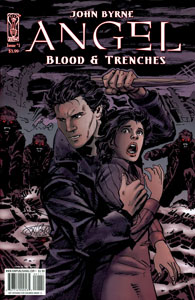In his first entry in the Buffyverse, comics legend John Byrne delivers the quintessential vampires-and-war saga, “Angel: Blood & Trenches” (March-June 2009). Previous stories had touched on this idea. In the novel “Spike and Dru: Pretty Maids All in a Row” (2000), vampires feast on soldiers in World War II and the Watchers’ Council sends a Slayer to thin the ranks of the undead. In the comic series “Spike vs. Dracula” (2006), Hitler recruits vampires to help his cause. The “Angel” episode “Why We Fight” (5.13) finds Angel and Spike thrown into WWII.
Those stories scratch the surface, but the four-issue “Blood & Trenches” lives up to its name as Angel desperately tries to minimize killing during World War I. His mission is pretty hopeless, and the punishment he takes is extraordinary – including one memorable sequence where he runs into the daylight, catches on fire, and stays alive only by covering himself with snow and eventually breaking through the ice into a river.
And that’s just the physical side of things. Byrne creates a palpable sense of how Angel is not evil yet not accepted by the side of good – the Allies, the Germans and the vampires all see him as their enemy. The yarn makes me think about how crucial it is for him to be accepted (even somewhat) by Buffy, et al, later on.
In the time of “Blood & Trenches,” knowledge of the vampire with a soul has only started to permeate the underworld, so when the vampires who are feasting amid the war’s carnage (similar to what they’ll do again in WWII, as per “Pretty Maids”) capture Angel, they mistakenly think his soul has given him human traits. They think they’re torturing him – rather than sustaining him — by feeding him blood. I dig Byrne’s idea that sometimes a hero can catch a random break – and certainly, Angel deserves one here.
Wesley’s grandfather, Council member Geoffrey Wyndam-Pryce, is pursuing this gang of vampires led by Kakistos. The ancient vampire will later become Faith’s nemesis before she offs him in “Faith, Hope & Trick” (“Buffy” 3.3), and it’s cool to see Angel’s run-in with the cloven-hoofed baddie in this series.
Byrne clearly put a lot of thought into the crafting of this story, which ends with a great final-panel twist that ties in with “Spike vs. Dracula.” Reading it is akin to following the storyboards of a movie, with some great set pieces. In addition to Angel using the snow to douse flames, there’s also a delicious scene where he is attacked by vampires rising from the snow all around him.
The narrative structure is clever, as in Issue 3 we double back to see the events up to that point from the perspective of Wyndam-Pryce. When we’re with Angel, we’re really with him, as he is the narrator. And we’re also immersed in the time, as everyone speaks old-time English.
The art is unusual, but excellent. Byrne only uses pencils, eschewing inks, but they are detailed pencils. This encourages a reader to spend a lot of time on each panel, and that’s another element that draws us into the tale.

“Blood & Trenches” has a third color besides black and white, though: Every instance of blood is shown in red. It’s most striking when Wyndam-Pryce comes upon a U-boat where Angel has torn through the German soldiers. Those panels are completely in red, and although we know Angel’s actions were borne of desperate hunger, we can see Wyndam-Pryce’s prejudice being shaped.
This series will appeal to fans of war stories, but it’s also a nice exploration of Angel as he’s tiptoeing into his hero identity and being put through the most extraordinary physical and psychological challenges. “Blood & Trenches” is a tasty style piece with a lot of substance.
Click here for an index of all of John’s “Buffy” and “Angel” reviews.

